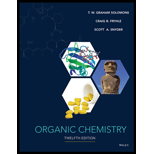
Interpretation:
The resonance contributors are to be discussed for the two possible protonated forms of acetamide.
Concept introduction:
The delocalization of electrons within the molecules is known as resonance.
The organic compound with molecular formula
The attraction between positively charged atoms and negatively charged atoms takes place due to the electrostatic force.
The rules for drawing resonance structures are as follows:
Only nonbonding electron pairs and pi electrons can participate in conjugation in the formation of various resonating structures.
The single bonds present in the molecule do not break or form in the resonance structures.
The placement of atoms present in the molecule remains fixed.
The octet of all atoms is completely filled.
Want to see the full answer?
Check out a sample textbook solution
Chapter 20 Solutions
ORGANIC CHEM. VOL.1+2-W/WILEYPLUS
- Complete the following acid-base reactions and predict the direction of equilibrium (to the right or to the left) for each. Justify your prediction by citing values of pKa for the stronger and weaker acid in each equilibrium. For values of acid ionization constants, consult Table 23.2 (Acid Strengths, pKa, of the Conjugate Acids of Selected Amines) and Appendix 2 (Acid Ionization Constants for the Major Classes of Organic Acids). Where no ionization constants are given, make the best estimate from the information given in the reference tables and sections.arrow_forwardComplete the following acid-base reactions and predict the direction of equilibrium (to the right or to the left) for each. Justify your prediction by citing values of pKa for the stronger and weaker acid in each equilibrium. For values of acid ionization constants, consult Table 23.2 (Acid Strengths, pKa, of the Conjugate Acids of Selected Amines) and Appendix 2 (Acid Ionization Constants for the Major Classes of Organic Acids). Where no ionization constants are given, make the best estimate from the information given in the reference tables and sections.arrow_forwardi) What property of amines is responsible for their being basic ii) Arrange the following compounds in order of increasing basic strength putting the least basic first. NH3 CH,CONH; O NH2 CH,CH;NH; D C. c) What general name is given to the reaction between phenylamine and nitrous acid at 5°C ii) Write the equation for the reaction in c(i). + Ajouter une légende.. > Statut (Personnalisé)arrow_forward
- Suppose you were given the structural formula of compound B but only the molecular formulas for compound A and the starting bicyclic amine. Given this information, is it possible, working backward, to arrive at an unambiguous structural formula for compound A? for the bicyclic amine?arrow_forward3. Rationalize the substantial differences in relative rates of alkaline hydrolysis for the following pair of amides: Ph N7 105 > Ph NH₂arrow_forwardWhich of these amines would produce the salt with the highest melting point if mixed separately with hydrochloric acid (HCl)? Based on the structure and properties of the resulting ammonium salts, explain your reasoningarrow_forward
- Vanillic acid is the oxidized phenolic derivative of vanillin. By using Proton Nuclear Magnetic Resonance ('H-NMR) spectroscopic technique, point out the difference that can be observed between vanillin and vanillic acid in terms of chemical shift based on its chemical structures. но Он Vanillic acid Vanillinarrow_forwardC) a nitrile D) an amine nitrite salt DIRECTIONS: Each of the following questions or incomplete statements below is followed by four suggested answers lettered A - D. Select or choose the letters of the best answer to the question or incomplete statement. 7. An organic nitrogen compound, X, gives ammonia on warming with dilute aqueous sodium hydroxide, X could be A) ethanamide B) ethylamine C) phenylamine D) amino ethanoic acid Which one of the following reagents reacts 1. in a similar fashion with both phenylamine (C H,NH,) and ethylamine. A) Br,(aq) C) conc. HNO, D) cold HNO (aq) 2. Phenylamine (aniline) can be prepared by reducing nitrobenzene with tin and concerntrated hydrochloric acid followed by the addition of alkali and finally steam distillation. The alkali is added to; A) prevent oxidation of phenylamine. B) liberate free phenylamine from solution C) dissolve excess nitro benzene D) dissolve the phenylamine 8. Arrange the following molecules in their increasing order of base…arrow_forwardHow do the following experimental results support the resonance description of the relative stability of acid chlorides compared to amides? The C-Cl bond lengths in CH3CI and CH;COCI are identical (178 pm), but the C-N bond in HCONH, is shorter than the C-N bond in CH;NH2 (135 pm versus 147 pm).arrow_forward
- How do the following experimental results support the resonance description of the relative stability of acid chlorides compared to amides? The C–Cl bond lengths in CH3Cl and CH3COCl are identical (178 pm), but the C – N bond inHCONH2 is shorter than the C – N bond in CH3NH2 (135 pm versus 147 pm).arrow_forwardAniline (conjugate acid pKa 4.63) is a considerably stronger base than diphenylamine (pKa 0.79). Account for these marked differences.arrow_forwardWhat will be the reason why Hinsberg’s method would fail to distinguish the three classes of amines if the compound to be analyzed isarrow_forward
 Organic ChemistryChemistryISBN:9781305580350Author:William H. Brown, Brent L. Iverson, Eric Anslyn, Christopher S. FootePublisher:Cengage Learning
Organic ChemistryChemistryISBN:9781305580350Author:William H. Brown, Brent L. Iverson, Eric Anslyn, Christopher S. FootePublisher:Cengage Learning Introduction to General, Organic and BiochemistryChemistryISBN:9781285869759Author:Frederick A. Bettelheim, William H. Brown, Mary K. Campbell, Shawn O. Farrell, Omar TorresPublisher:Cengage Learning
Introduction to General, Organic and BiochemistryChemistryISBN:9781285869759Author:Frederick A. Bettelheim, William H. Brown, Mary K. Campbell, Shawn O. Farrell, Omar TorresPublisher:Cengage Learning Organic Chemistry: A Guided InquiryChemistryISBN:9780618974122Author:Andrei StraumanisPublisher:Cengage Learning
Organic Chemistry: A Guided InquiryChemistryISBN:9780618974122Author:Andrei StraumanisPublisher:Cengage Learning



